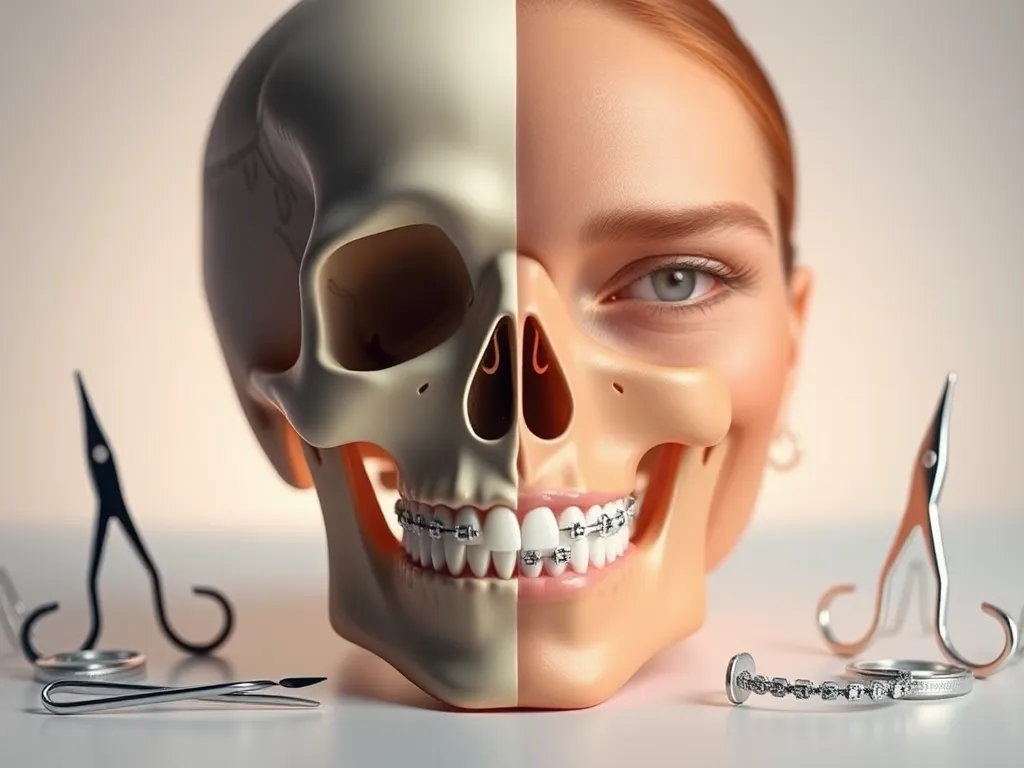Understanding the Impact of Orthodontics on Facial Aesthetics

The Intersection of Orthodontics and Facial Aesthetics
Orthodontics and Facial Aesthetics serve as pivotal components in modern dentistry, focusing on the alignment of teeth and the enhancement of facial harmony. Orthodontics involves the diagnosis, prevention, and treatment of dental and facial irregularities, whereas facial aesthetics refers to the visual appeal of facial structures. Together, they aim to improve oral health, boost self-esteem, and create a balanced and attractive facial appearance.
The implications of orthodontic treatment extend beyond just dental alignment; they profoundly impact facial aesthetics. Well-aligned teeth and jaws contribute significantly to an individual's profile, enhancing facial symmetry and overall beauty. As such, orthodontics plays a critical role in sculpting not only a functional bite but also a more attractive face, demonstrating the deep connection between oral health and facial appearance.
In recent years, the relationship between orthodontics and facial aesthetics has gained immense interest, with more patients seeking orthodontic treatments to achieve not only functional benefits but also enhanced attractiveness. Techniques such as braces, aligners, and jaw surgeries are not only about correcting malocclusions but also about achieving a harmonious facial profile that aligns with contemporary beauty standards.
The rising awareness of facial aesthetics among patients has spurred orthodontists to adopt a more holistic approach. This involves considering the facial proportions, profile, and aesthetic goals of each patient when planning orthodontic treatment. As a result, orthodontics and facial aesthetics are increasingly viewed as inseparable, with comprehensive treatment plans tailored to meet both oral health needs and aesthetic desires.
Moreover, the evolution of orthodontic technology and techniques continues to provide patients with a variety of options that align with their aesthetic preferences. With treatments becoming less invasive and more aesthetically pleasing, orthodontics has become a vital aspect of the broader scope of facial aesthetics, allowing individuals to achieve their desired appearance while improving their dental health.
The Role of Orthodontics in Facial Morphology
The positioning of teeth plays a significant role in determining facial structure and overall morphology. Proper alignment contributes to balanced facial features, while misaligned teeth can lead to asymmetry and other aesthetic concerns. When orthodontic treatment aligns teeth and improves their positioning, it enhances the overall appearance of the face, creating a more harmonious look.
Braces and other orthodontic appliances can lead to changes in jaw alignment, significantly impacting facial structure. By correcting malocclusions, orthodontics can enhance the profile of the face, promoting a more attractive jawline and improved chin prominence. These changes are not limited to aesthetics but also benefit oral function, providing individuals with a more comfortable bite.
Orthodontic treatment also plays a crucial role in achieving facial symmetry. As teeth are aligned and jaws are repositioned, patients often experience noticeable improvements in facial balance and harmony. This impact on symmetry is key in enhancing a person's attractiveness and is a primary goal for many individuals seeking orthodontic solutions.
Psychological Effects of Orthodontics on Self-esteem
Orthodontics and facial aesthetics significantly influence body image, with braces often associated with both positive and negative perceptions. While some individuals may initially feel self-conscious due to their braces, many report improvements in body image and self-esteem once treatment is completed and their desired smile is achieved.
Patient confidence can drastically change before and after orthodontic treatment. Many individuals who pursue orthodontics often do so out of a desire to enhance their appearance and boost their self-confidence. The transformation resulting from an improved smile can lead to a heightened sense of self-worth and increased social engagement, demonstrating the psychological benefits of orthodontics.
Social perception plays a critical role in how individuals view themselves and are viewed by others when wearing braces. Studies indicate that individuals with aligned teeth are often perceived as more attractive and competent, further emphasizing the psychological benefits of orthodontic treatment. Such perceptions can influence personal relationships, professional opportunities, and overall quality of life.
Orthodontic Treatment Techniques
Traditional braces remain a popular choice for orthodontic treatment. These fixed appliances are highly effective for correcting various malocclusions. However, they can sometimes impact aesthetics due to the visible metal brackets and wires. Nonetheless, orthodontists are now more focused on minimizing the aesthetic concerns associated with traditional braces, making them a less daunting option for patients.
Invisalign and other clear aligners have grown in popularity as aesthetic alternatives to traditional braces. These custom-made, removable aligners provide a discreet way for individuals to straighten their teeth without the noticeable appearance of metal braces. Their effectiveness and aesthetic appeal make them a preferred option for many, particularly adults seeking orthodontic treatment.
Lingual braces are yet another aesthetic option for patients looking for effective orthodontic treatment without the visible presence of traditional braces. These braces are custom-designed to fit on the inner surfaces of the teeth, making them virtually invisible. Lingual braces offer the same corrective benefits as traditional braces while maintaining aesthetic discretion, appealing to individuals conscious of their appearance during treatment.
Long-term Effects of Orthodontics on Aging
Research has shown that orthodontics can play a significant role in influencing the aging appearance of individuals. Maintaining proper alignment of teeth can prevent premature aging signs like sagging or drooping facial features. Straight teeth and a healthy bite contribute to the structure of the face, helping individuals maintain a youthful appearance well into their later years.
For older adults, teeth straightening through orthodontics can provide numerous benefits. Beyond aesthetic improvements, aligned teeth make oral hygiene practices more effective, which is crucial for preventing dental issues that can arise with age. Improved oral health contributes to overall wellbeing as individuals age.
Preventative care through orthodontics can be a powerful tool in promoting long-term dental health. Early detection and treatment of potential orthodontic issues can help in avoiding more serious problems later in life, preserving both oral health and facial aesthetics. Through proper orthodontic care, individuals can enjoy both functional benefits and aesthetic enhancements throughout their lives.
Cultural Perspectives on Orthodontics
Orthodontic practices vary widely across different cultures, with some societies placing a higher value on achieving a perfect smile than others. In many Western cultures, orthodontics is viewed as a standard treatment for children and adolescents, while in other regions, it may be seen as a luxury or unnecessary expense. These variations highlight the cultural importance placed upon dental aesthetics and alignment.
Beauty standards significantly impact orthodontic expectations as individuals seek treatments that align with societal ideals of attractiveness. In cultures where straight teeth and perfect smiles are synonymous with beauty, the demand for orthodontic treatments is higher. This creates a dynamic where orthodontics is not merely about health but also about conforming to cultural beauty ideals.
Cultural perceptions can deeply influence orthodontic decisions, affecting the willingness of individuals to pursue treatment. In cultures where orthodontics is highly regarded, patients may be more motivated to seek out orthodontic care to align with social norms. Conversely, in cultures with less emphasis on dental aesthetics, individuals may prioritize other aspects of health and wellbeing over cosmetic concerns.
